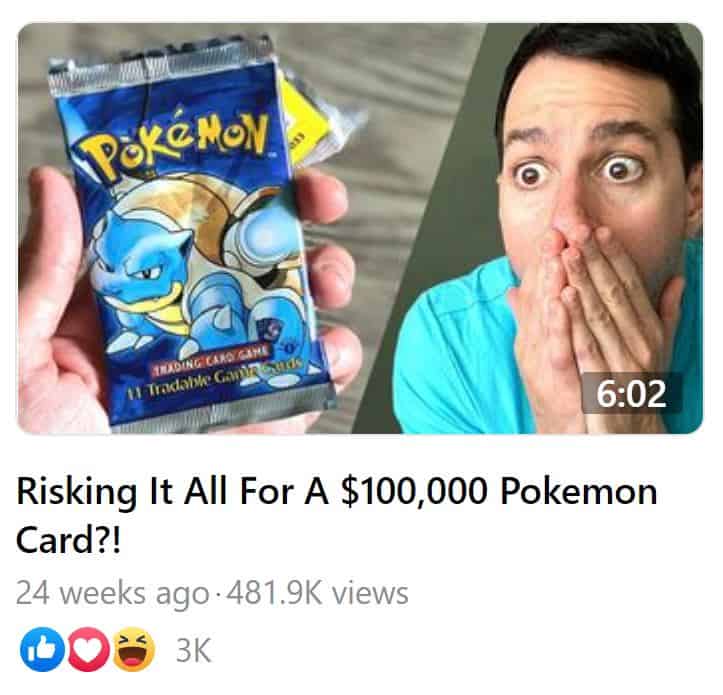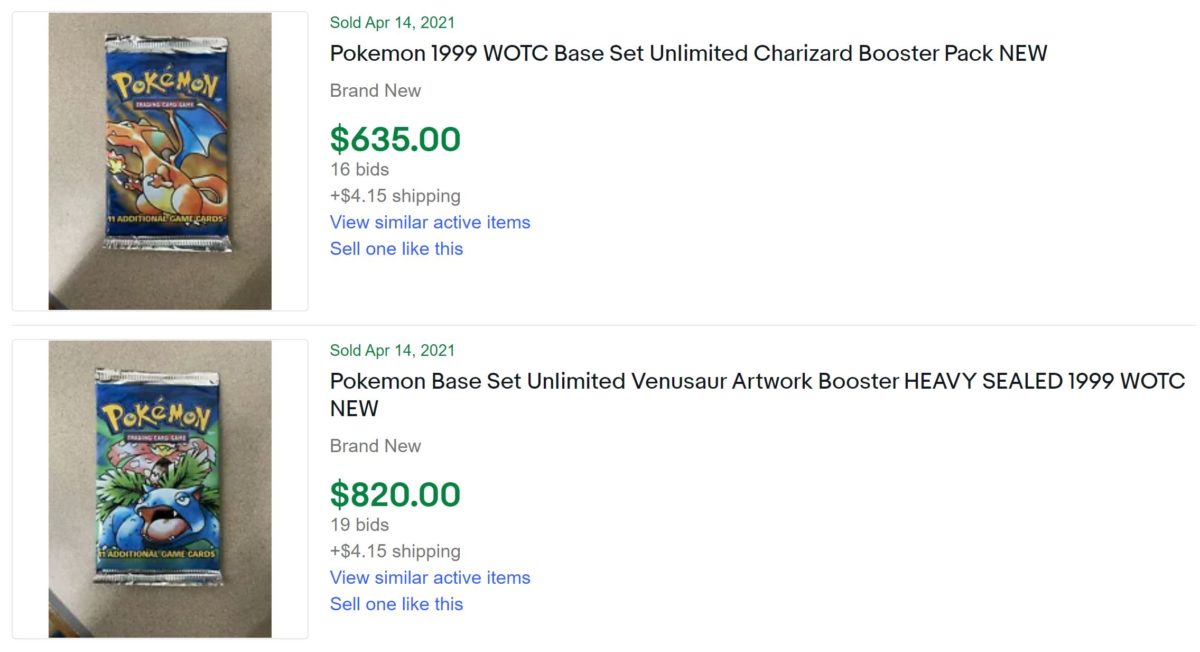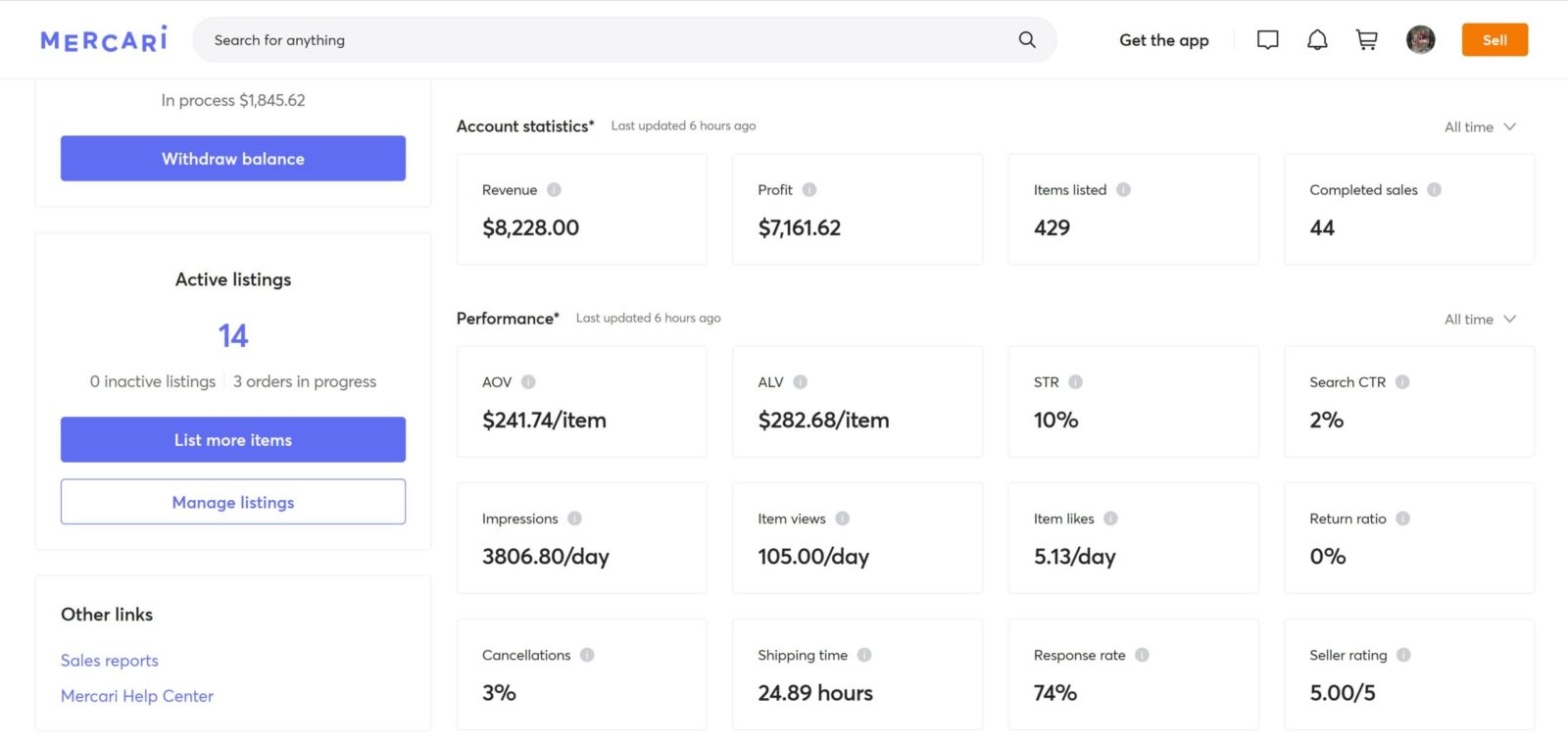I Spent $100K Flipping Pokémon Cards. Here’s How It Went
Our readers always come first
The content on DollarSprout includes links to our advertising partners. When you read our content and click on one of our partners’ links, and then decide to complete an offer — whether it’s downloading an app, opening an account, or some other action — we may earn a commission from that advertiser, at no extra cost to you.
Our ultimate goal is to educate and inform, not lure you into signing up for certain offers. Compensation from our partners may impact what products we cover and where they appear on the site, but does not have any impact on the objectivity of our reviews or advice.
With a naive sense of confidence, I spent six figures buying and selling Pokémon cards during the pandemic-fueled TCG boom. Here's how I fared (and a few lessons I learned) during my trip down nostalgia lane.
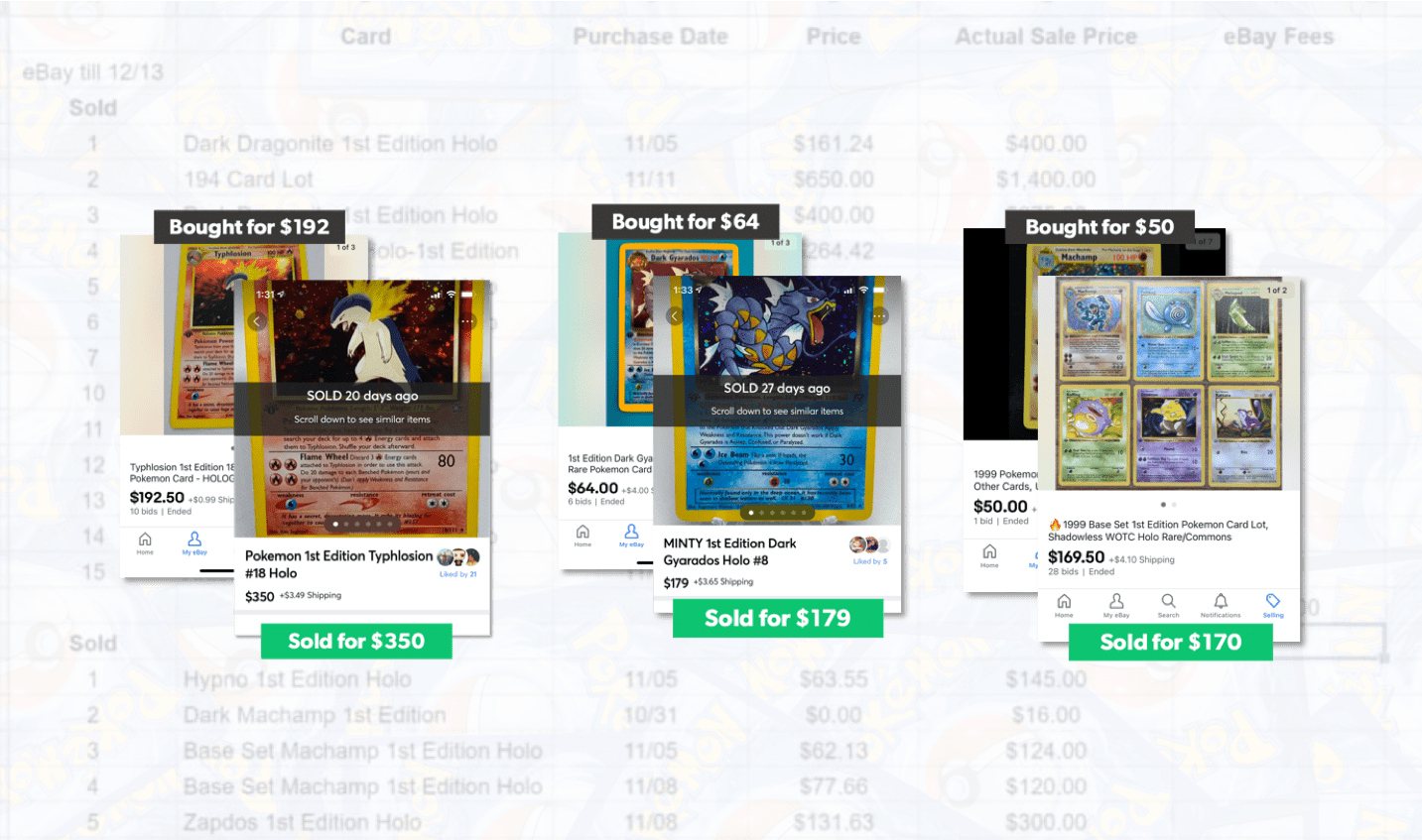
If there were a silver lining to be found amidst an angst-filled 2020, it was that many people had the free time to rediscover things that were previously important to them.
Reconnecting (virtually) with old friends, their love for being outdoors, a rekindled fire for an old hobby. You name it, we learned a lot about what we used to do during our downtime way back when handheld technology didn’t occupy our every waking moment. After all, even binge-watching Netflix gets boring after a few weeks.
The latter of those aforementioned rediscoveries — an old hobby — turned out to be the most unexpected, but one of the more welcome, developments to resurface during my last trip around the sun. Six months and six figures later I’m sharing the lessons I learned flipping Pokemon trading cards to make money during the pandemic.
A Pleasant Surprise
It’s mid-October and I’m trapped at home like millions of other Americans, weary of the restrictions put in place to help stop the spread of COVID-19. (I work from home, so this isn’t new to me. But I do enjoy the occasional Starbucks workday.) I’m mindlessly scrolling my Facebook news feed and up pops the dreaded “Suggested for You” section that almost never contains content I’m actually interested in.
But today was different. Today, Facebook’s algorithm accidentally guessed correctly. (The digital marketer in me can appreciate the cookie-setting, browser-spying, API-integrating, web property-tracking behemoth that Facebook is.)
They flashed the one headline my eyes (and mouse) simply couldn’t gloss over.
I was flabbergasted. I had those. A whole binder full of those. Who didn’t? A late-eighties baby, I turned double digits at the height of the Pokemon boom.
For several years, I begged my mom to buy me single packs at a local card shop, Target, 7-Eleven, wherever one could find them. Laughably, I did chores at an unprecedented clip.
The shiny cardboard. The glossing over them with friends on the school bus. The immense jealousy of the kids that had better cards (that their parents bought them, cheaters).
The nostalgia.
I watched it, the entire video. All 25 minutes of it. (Spoiler alert: Leonhart didn’t pull a $100,000 card in that video, but he did pull one worth $500,000 in this later-published video.)
And just like that, I was entirely re-hooked. The child-like giddiness of getting to watch someone open packs, and of course, wanting to now do it myself, had re-emerged.
Reality Check
And just like that, the brakes got pumped. A quick eBay search showed the packs that I was accustomed to forking over $2.99 for in 1999 had swelled to over $600 each.
Turns out that when the most popular franchise of all time (and it is not even close) stops printing the original vintage cards, nearly twenty years later, the price continues to increase as supply drops.
After all, it’s not like they printed unlimited sealed packs. Wizards of the Coast (the original designer-manufacturer of the cards in the U.S.) produced a few tens-of-thousands of sealed packs of various print runs, and that was it. Production stopped in 2003, and the rest is history (Nintendo took over and began their own card series).
To add salt to my now wounded psyche, I discovered I had done what every 2020 Pokemon re-discoverer kicked themselves for. I sold my entire collection on eBay years earlier for what now amounted to pennies on the dollar. $112.00 for entire completed Base, Fossil, and Jungle sets, among other assorted incomplete sets/semi high-value cards. Fail.
Not all hope was lost, however, as now, twenty years later, I was armed with two very important pieces of ammunition to once again rebuild my collection: disposable income and digital marketing knowledge.
Turning a Hobby into a Side Hustle
To the fervent card collector, one who holds the view that a card’s intrinsic value is measured in memories, not its monetary worth, the rest of this article may present as a nuisance plaguing the hobby.
But I promise there are several ways to flip undervalued cards without harming the hobby in the same way that scalpers prevent the next generation of Pokemon lovers (and nostalgic adults) from finding product on modern store shelves.
And to that effect, that is where my October Pokemon rediscovery began. I spent weeks in early-to-mid October studying the value of the vintage products I was already familiar with — both sealed packs and single Wizards of the Coast (WOTC)-era cards.
(The modern Pokemon sets also have higher-value cards — in the several hundred to even several thousand dollar range — but I felt like I didn’t know enough about them yet to devote income/resources to cards I didn’t fully understand.)
I wanted to make at least semi-informed decisions about the cards I was buying. I wanted to have a systematic way of approaching and identifying undervalued cards, and an equally systematic way for selling them, taking any guesswork/emotional attachment out of the process.
Related: 41 Ways to Make Money Fast
Developing a Working System
My initial due diligence led me to discover that eBay “comps,” as they’re called, were an easy way to get a snapshot idea of what recently sold cards were going for that week.

Furthermore, third-party enthusiast sites like TCGplayer or even grading services such as Professional Sports Authenticator (PSA) have indexes that allow you to see, perhaps most importantly, the historical trends of raw and graded card prices.
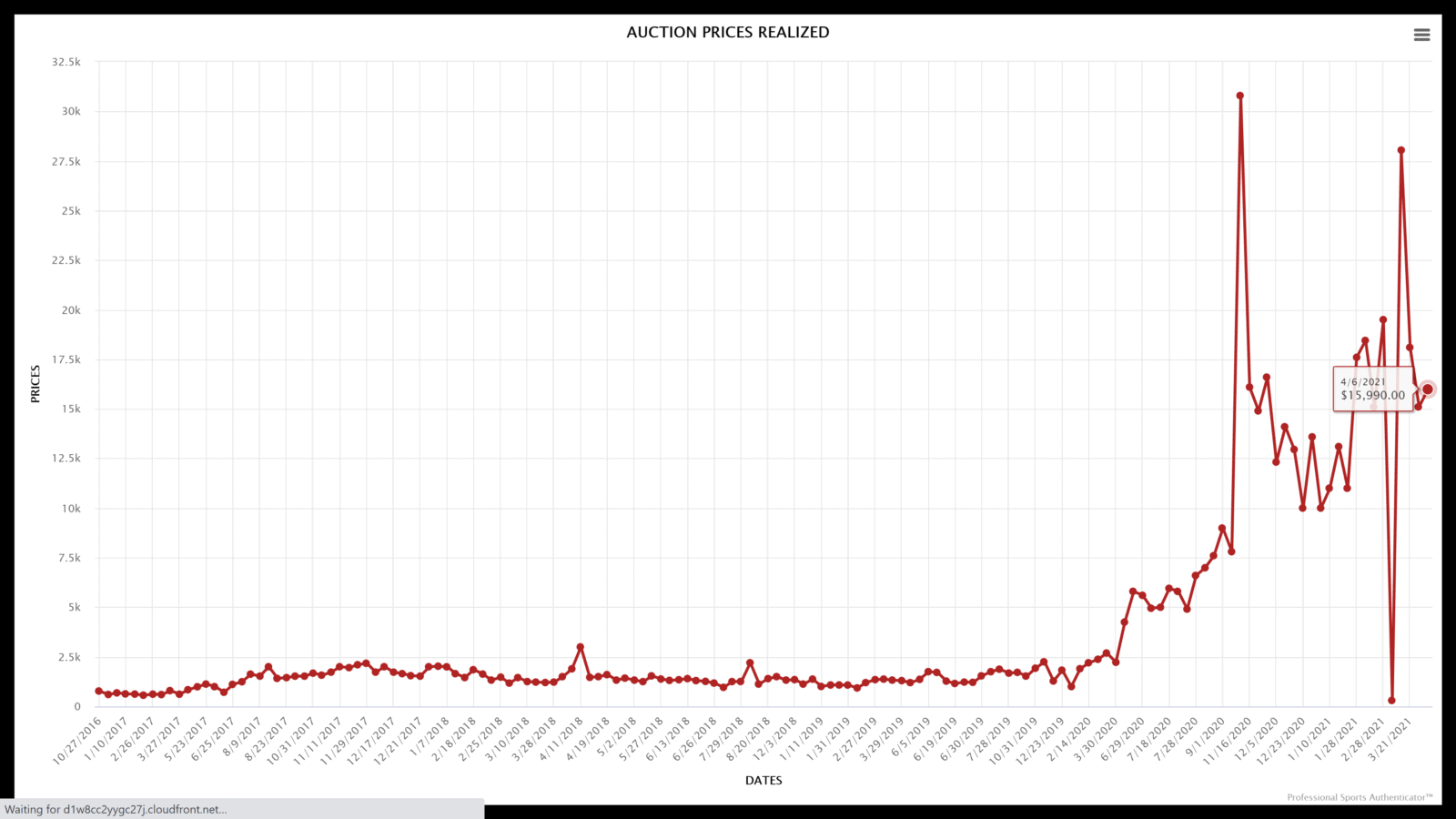
Using these sources, you can quickly construct a spreadsheet of the current market value of cards circulating on for-sale platforms. During my research, I built a sheet that tracked the prices of popular vintage cards in the original WOTC prints — and mostly holographic cards, at that.
I intentionally went for higher-value cards not only because they had higher margins (and downside protection against occasional losses) but also because of their enhanced liquidity/sales volume (they are generally more sought-after cards despite their relative rarity).
Now, I had never forayed into card-grading as a pre-teen. But it quickly became apparent that getting max-value for a specific Pokemon card was to acquire near-mint to mint versions of high-margin cards and then send them in to get graded (which increases the value anywhere from 2-10x the “raw” or ungraded value of the card).
There was only one problem: grading cards takes time and the market can move quickly — especially with the bubble/meteoric rise in card prices that the pandemic brought about.
With turnaround times at major grading services ranging anywhere from a few days to over a year, I didn’t want to absorb the risk of buying cards, sending them off to get graded, and then have to watch helplessly as the price point/support that I bought the raw card at get decimated as card values were to fall (and I didn’t have my card back from the grading service yet).
With that reduced risk for appetite in mind, I began to acquire inventory to resell. At first, it was single raw cards I was able to find on eBay that fell well below the 7-day average or “market price” as dictated by eBay comps. It then stretched to modest-sized binders and collections. Lastly, I got comfortable identifying undervalued, authentic sealed vintage WOTC products and flipped those, too.
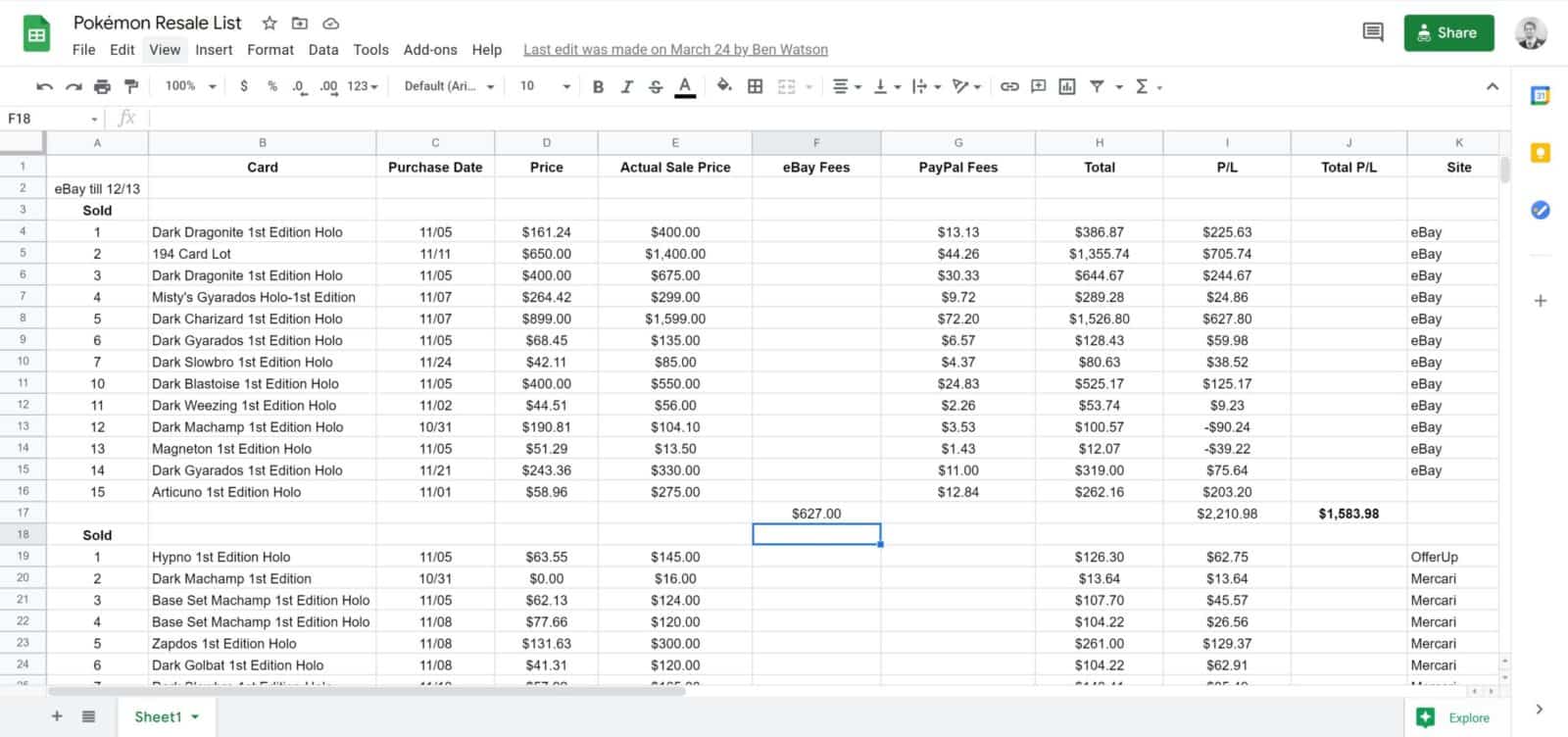
My initial results were promising. I had managed to turn about $4,000 in flipping profit over the first 40 or so transactions over a two-week period. This initial success only fueled my curiosity to see if I could scale things higher.
What’s not to love about potentially marrying a fun hobby with a realistic way to make meaningful side hustle income?
But, as with any complex business system, I quickly found out that my primitive method for tracking inventory, and their ensuing sale, grossly fell short of the level of organization needed to flip dozens or even hundreds of cards — often duplicates — at the same time.
Soon, every card or pack that I acquired was assigned a specific stock number. That way when it got listed across several platforms, there was no confusion as to which duplicate card a customer was seeing (in the photos) or worse, the card they were getting (an accidental mixup of two similar-looking cards).
The ruthless level of detail was absolutely necessary to nix chaos and ensure prospective buyers were getting exactly what they intended to receive.
My Results So Far
Treating the entire operation as almost a business from the get-go, despite the aura of nostalgia that got me back in it, helped me stay in the black where others might have struggled.

I quickly turned to flipping what I would define as mid-range cards (personal opinion) in the $100-$500 range.
This allowed me to reclaim a portion of my sanity, recoup/save on supplies and packaging costs, and reduce the amount of time spent getting the cards out of my possession once I acquired them.
Over the last six months, my numbers look roughly as follows:
- $103,789.23 in gross spending (include cards, packs, shipping, fees, etc.)
- $112,172.46 in revenue across all platforms
- ~$21,000 in raw card/pack inventory (based on current market value)
- ~400 cards at third-party grading services with a declared value of approximately $50,000 (based on current market value and their anticipated grades)
What blows my mind about this entire process is that there are sellers that dwarf these numbers in terms of sales and sophistication of operation.
I would speculate there are some dealer-sellers easily clearing multiple six-figures per month selling high-end “slabs” (graded cards) or collections given the current climate.
All in all, I’m happy to have turned a very good profit over the past six months with a high-revenue ceiling yet to be realized as I continue to sell the inventory I’ve acquired.
With a high AOV (average order value) and a robust historical profit/item, I anticipate crawling closer to $200,000 in total revenue over the next three months.
For anyone curious, my biggest “hit” was a raw 1st Edition Sabrina’s Gengar I bought for $300 on eBay. I happened to have an order going to PSA that I snuck it in on and it came back a PSA 10 (GEM MINT). I sold it shortly after and netted $6,000.
(It was such a low population card I probably should have held onto it and now I’m kicking myself for selling this particular one. 👻)
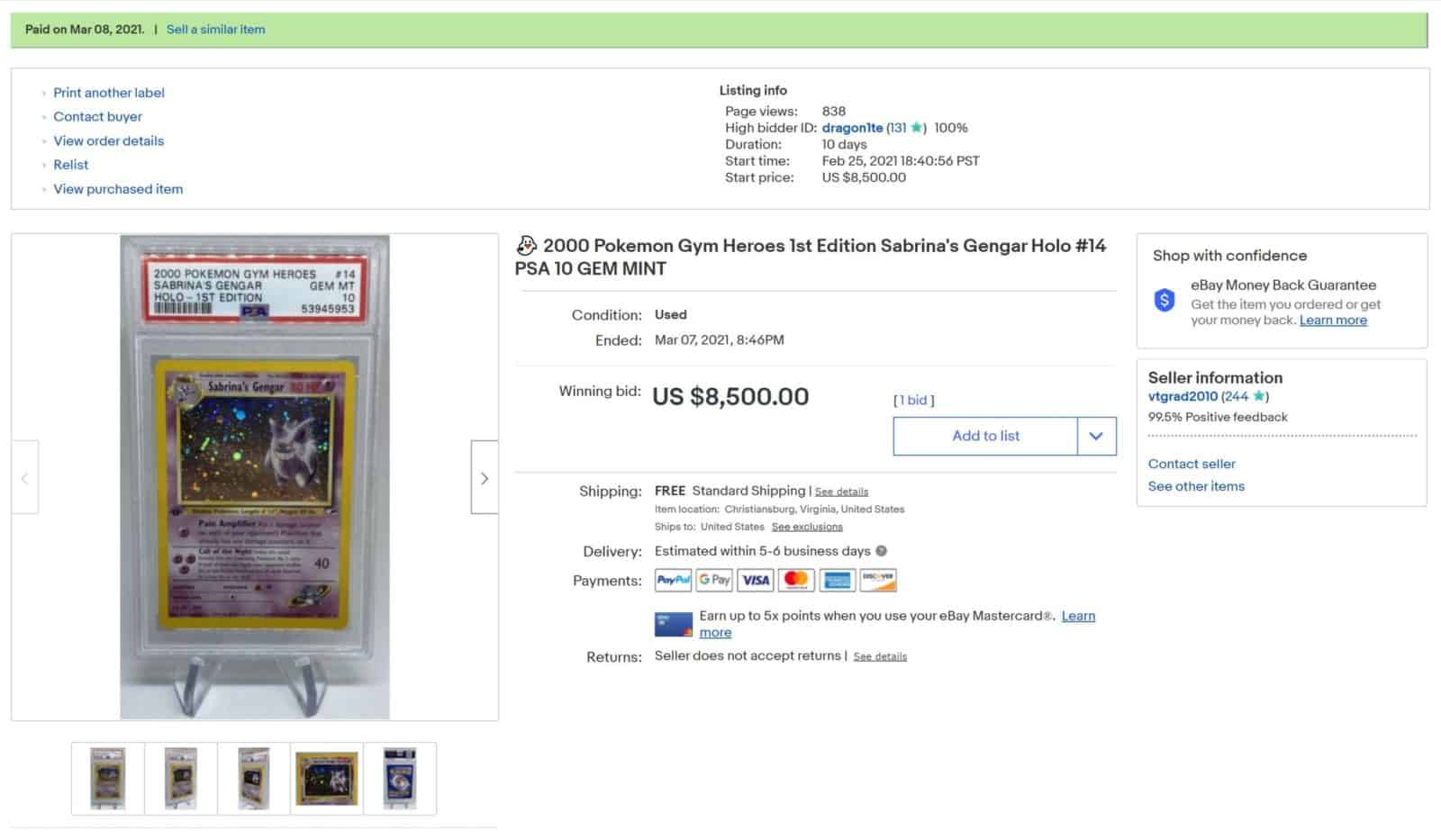
Tips for the Buying Side
Ah, yes, the fun stuff. Whether you’re an avid collector just looking to score a good deal, or you too are interested in trying your hand a flipping a few undervalued cards, my hope is you’ll pick up a tip or two from what I’ve learned along the way.
1. Look for deals during off-hours.
I’m located on the East Coast of the United States. Coincidentally, several studies have shown that eBay activity, or internet traffic in general, is highest during primetime — or between 8-11 PM EST.[1]
That’s when the highest number of people have free time to scour the web with the intent of making a purchase. It’s also the time you’re most likely to compete with other bidders/buyers for a potential card you’re interested in. Great for sellers, bad for getting the best price on a card.
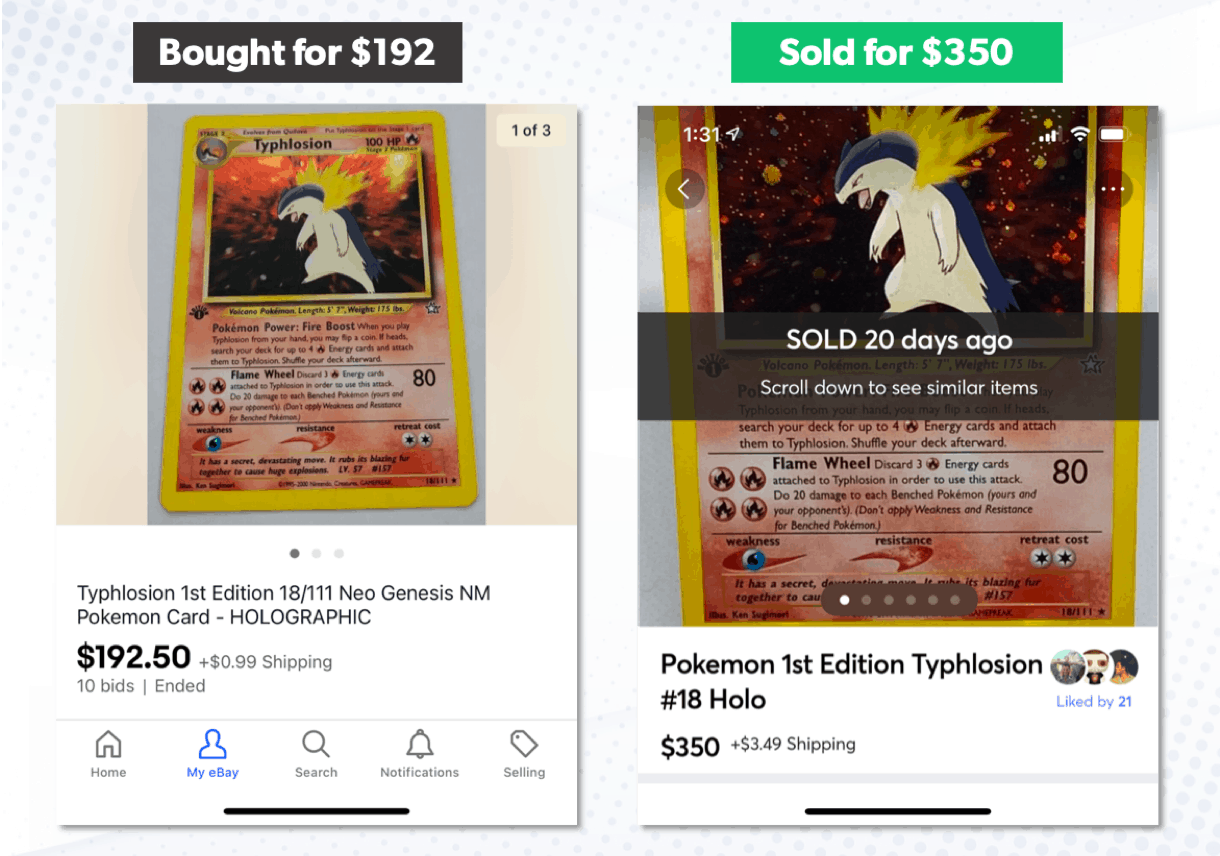
I have a newborn and so, as luck would have it, I was often awake at super-off hours stateside. This often led to me stumbling/saving eBay auctions that ended at obscure hours, and with fewer competing eyes.
At least 50% of the acquisitions I make are between twelve-midnight and twelve-noon the following day. There are simply fewer people to compete with.
2. Set an all-in price for a card and never go over it.
Take any emotional attachment you have to a card — assuming you’re interested in flipping for profit and not keeping it for your personal collection — and toss it out the window. Learn the value of cards you’re interested in, set a max price in your head, and never exceed it. Ever.
It’s like a stop-loss when trading stocks. You can’t lose more than what you pre-determined was an acceptable exit point. This will give you breathing room when you go to sell.
3. Set search filters wide on whatever platform you search on.
Unless you’re specifically dabbling in very high-end cards — let’s say $1,000+ — you’ll likely need to acquire dozens of cards at a lower price point to generate meaningful income.
Perhaps the best way I’ve found deals on any platform is to capitalize on poorly “Titled” or “described” cards.
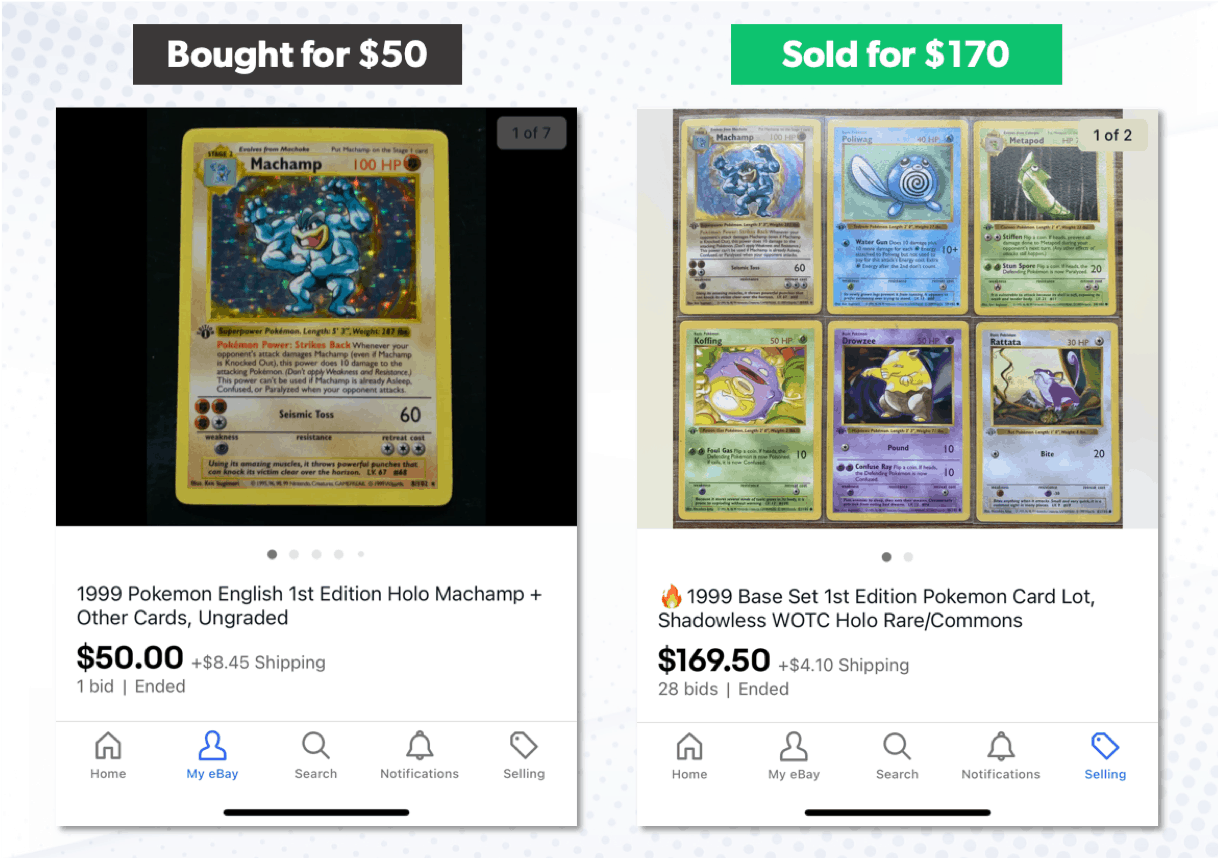
In the example above, the listing seller took a photo of a single card that, in actuality, represented a lot of fairly lucrative cards. This particular single card is a somewhat common, easily skipped-over item, which resulted in me winning the auction for a fraction of its market value.
By searching categorically (either literally through categories on platforms and/or by using generic search terms like “1st Edition Pokemon”, I’m able to find listings with horrible typos, scant details, and/or otherwise genuine/authentic cards that are getting far less attention than they should.
Again, this inevitably leads to fewer competing eyes for often high-value lots that just get drowned out by thousands of other listings.
4. Find your cash cow.
Simply put, some cards will present better prospective opportunities because of their liquidity/popularity. Cards with high-volume sales often compete with one another for search visibility on auction sites. That leads to a few cards slipping through the cracks that sell for way below what the market generally says they’re worth.
By using saved search filters, I’ll add hundreds, sometimes thousands of listings to my watchlists across several platforms and snipe auctions that are clearly underperforming.
5. Be active.
To diversify risk and actually acquire a decent amount of undervalued product, it’s important to be active throughout the day. Many of the items I found were newly listed items that had “buy-it-now” or “make an offer” features available.
Frequently, casual sellers will grossly underprice the cost of goods, or they’re a motivated seller who intentionally lists at a lower price to get cash quickly. Dozens of times per day, this exact phenomenon occurs and it’s simply a race for who can spot them first.
6. Be extremely careful.
I will scream this one to the high heavens. If you’re impatient and/or not technologically savvy/familiar with common online [payment] scams, do. not. buy. or. flip. cards.
Every platform has some level of buyer protection. Every payment processor has some form of buyer protection. Know them intimately. If you find yourself tempted to skirt the systems that are designed to keep you safe for convenience or to save on fees, you will get burned. Promise.
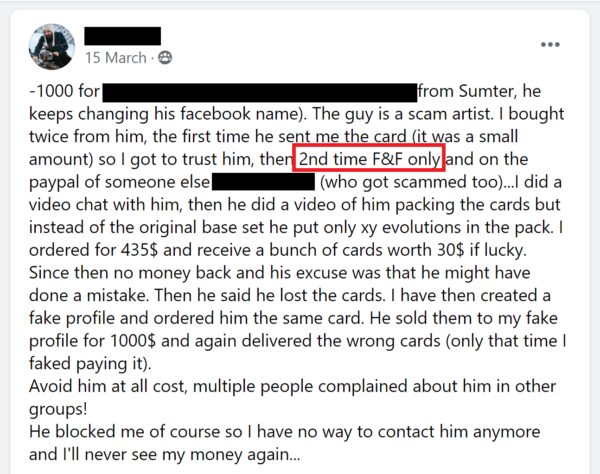
Every veteran card collector/flipper there is will scold you and not bat an eye of sympathy when you get burned.
7. Source your cards from a variety of places.
eBay may be the most familiar to many, but it’s definitely not the cheapest place to find cards to flip. In-person sales, classifieds, estate sales, Facebook marketplace, niche Facebook groups — almost all of them present a better way to find items to flip so long as you adhere to the principles learned in #6 (be careful!).
8. Buy in “bulk.”
Generally speaking, you’ll almost always get a better per-card price when you scour listings for more than one card. It’s easy to see why. Simply put, it’s easy for collectors/lay buyers to accurately price a single card given the sources mentioned earlier (TCGplayer, eBay, PSA, etc.).
It’s much harder and much more work to accurately price a small or even huge collection of cards. Alas, where there is hard work, there is money to be made. Fewer people are willing to put in the minutes or hours it takes to price a collection. You can score huge deals on bigger lots once you feel comfortable in what you’re looking at.
Even small lots of 2-3 cards can come in steep discounts.
9. Learn to spot fake cards and packs.
If you can’t accurately spot fake cards not in person, there’s a pretty good chance you’ll get burned here, too.
Unfortunately, a byproduct of pandemic reemergence is the similar rise in fake product designed to cash in. Advances in technology have made identifying fakes harder than ever before, but the heavy scrutiny of cards by an experienced collector can still catch nearly all instances.
10. Be a repeat buyer.
And on that note, be easy to work with and pay promptly. I have several sellers that will actually reach out to me to see if I am interested in inventory before they go through the hassle of photographing things and listing them on platforms. Similar to developing a reputation as a trusted seller, look for ways to become a go-to buyer.
11. If it doesn’t have excellent pictures, don’t buy it.
The trap that literally everyone (including myself) falls into. Buying single cards on the internet is a dangerous proposition, especially if you’re buying them with the intent of getting them graded to sell at an even higher price.
Your eyes will fool you. Sellers will intentionally (or unintentionally) fool you. Whatever condition you think a card is coming in, odds are it’s coming in one tier worse than your most optimistic expectation. Sellers know if they showcase/highlight every flaw on a card, they’ll lose value because who wants to pay for damaged goods? (More on how this may actually be wrong below.)
Instead, they’ll intentionally obfuscate the true condition of the card by using poor lighting, reflections, poor angles, etc. Anything they can do to hide flaws (this is the very cynical side of things). On the other hand, you have generally well-meaning but naive sellers who are just offloading their childhood collection who don’t mean to take poor pictures/hide things. It just happens.
Simply put, if there aren’t half a dozen or more pictures showcasing every possible angle, and/or at least a few stupidly high definition photos of the front and back, do not buy the card.
Tips for the Selling Side
Once you’ve spotted and purchased a few good cards, here are some tips for flipping them for the highest profit.
1. Have your listings end at opportune times.
Remember how we said buy at off-hours? The opposite is true for selling.
Third-party research gives us a pretty good idea of the days and times of the week where there is the highest activity (and highest sale value) for items sold on major platforms like eBay. Don’t make the mistake of having your listing end at obscure times. No one will see it and you won’t get close to the max value for it.
2. Take (lots of) high-quality photos.
Remember how I said people are afraid to take pictures because they highlight flaws?
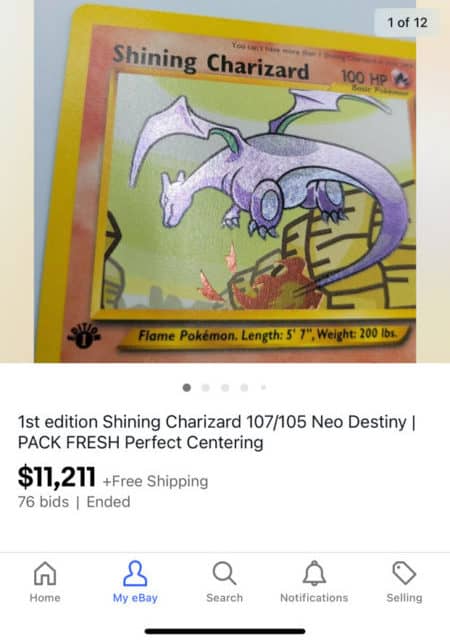
On the flip side, numerous high-quality pictures can massively grow a prospective buyer’s trust.
Perhaps one of the best flippers I know takes obscenely good photos of his high-value raw singles.
He will literally highlight the flaws of the cards in neon colors, snapping nearly a dozen different angles showing the entire surface area of the card.
And you know what?
His mint condition raw/ungraded cards regularly fetch prices 30-40% higher than their graded PSA 9 equivalent would fetch.
3. Learn search optimization.
This brings me to my absolute favorite part about being a flipper. The strategy behind the perfect listing. As a marketing specialist for this blog, it’s my job to get readers to our content. Similarly, it’s my job to get relevant (not necessarily the most) eyeballs on my card listings. This is where search optimization comes into play.
- Learn about keyword optimization for the specific platform you’re selling on (here are eBay’s SEO suggestions).
- Learn what makes a good thumbnail/feature photo that maximizes CTR (click-through rate).
- Figure out what gets people to save/watchlist/engage with your listing (hello, algorithm boost).
Like I said earlier, poorly optimized listings are where I find the bulk of my good deals. Don’t be the person who gets half-value for otherwise great cards.
4. Cross-sell on several platforms.
If you’ve got the time, look into listing your inventory on several of the best places to sell Pokemon cards. This allows you to establish a seller reputation in several different areas and exposes you to new pools of prospective buyers.
Just be careful. Check in frequently when items sell to ensure you’ve de-activated those listings on other platforms if necessary.
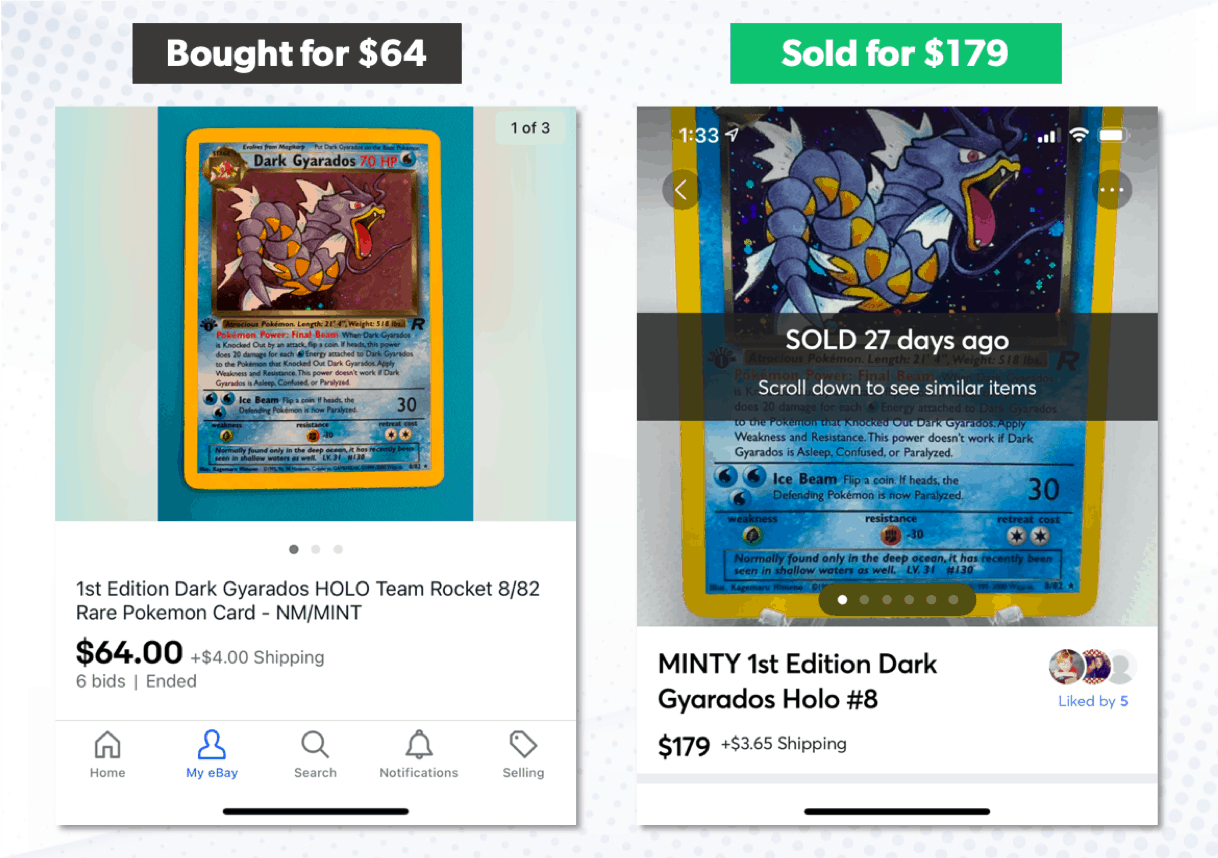
Better yet, if you have potential buyers in two places, you can “leverage” them against one another by disclosing you have multiple interested parties. Like buying a house, one may put in a better offer above your asking price because that’s what the card is worth to them.
5. Become familiar with promotional methods.
Platforms like Mercari and eBay have robust seller tools for getting extra exposure on your listings, often for a very reasonable cut. If you’re flipping cards, it may be of interest to offload quickly as market conditions are changing.
Sometimes it’s better to take less profit than holding and taking a loss, especially if you have cash flow concerns. Furthermore, Mercari even has free promotional options that enhance exposure without them getting a hand on the final sale price. Take advantage of any option you can find that gets your listings in front of more relevant buyers.
6. Lock in profits.
Like buying, holding, and selling a stock, if your aim is to generate profit, then you need to consistently take money off the table when you have it locked in. In a momentum-based market, it’s important to cash in on your medium-speculative purchases that don’t have a high ceiling. This is basically true of all raw cards outside of a select few, 1st Edition Base Set cards.
If you hold out in hopes of selling a raw card at a higher price down the road, you may end up taking a heavy loss if it doesn’t possess the rarity to continually appreciate in value.
7. Buy in “bulk”.
Not cards this time — shipping supplies. Soft sleeves, toploaders, Card Saver 1s, bubble wrap, peanuts, cardboard, doesn’t matter. This junk is expensive if you buy it in small portions. If you’re making a serious time investment in the hobby as a flipper, make a small monetary investment in bulk supplies that will save you loads and pad your margins down the road.
8. Avoid fees and simplify your listings.
eBay is great for determining and getting the market value for your cards. But, sometimes you can get above market value when you sell in-person or in niche Facebook groups. While eBay is a great platform, there are still areas rife with fraud. Some collectors will only purchase and sell in niche groups and will pay an added premium to stay off the bigger platforms.
Better yet, when you sell on those platforms, you can leverage tools like PayPal Goods & Services, whose 3% fees are a far cry from eBay’s brutal ~14% (as of 04/21) managed payments fee in the TCG category.
And on that note, try to avoid the listing upsells if you’re selling dozens of cards. Those fees will crush your bottom line and I’d reserve using those for cards that have at least $500 in value. (Personally, I’d only use them if they had $2,000 or more in value.)
Where to Go from Here
I should probably clarify that I am by no means an expert. Perhaps an above-average informed enthusiast, at best. My biggest piece of advice is to guard yourself against overvaluing your cards and/or overvaluing a card you’re interested in purchasing. This is seemingly rampant in the industry, and it doesn’t factor in well to your bottom line when you try to flip cards that people don’t value the same way you do — especially when those people are professional card graders.
Fortunately, I found a money-making gig that not only helps pay the bills, it also extinguishes the urge to constantly rip open expensive packs with no way to recoup my entire [soon-to-be lost] paycheck. And at the end of the day, I’ve still got a bunch of inventory to sell, so stay tuned to see where it goes from here.
If this is the first story you’ve read about Pokemon’s pandemic boom, I urge you to hop over to YouTube and dwell on the likes of Leonhart (1.4 million subscribers) and PokeRev (over 300k) as they serenade you with memories of the Pokemon glory days. From daily pack openings, card gradings, and general goofing off, I thank them for hours of cool content over the past 6 months I got to enjoy while locked up at home.
What about you? Have you bought or sold Pokemon cards with some level of success? Let us know what other tips you have for snagging deals or getting the most out of your cards (when selling them) in the comments below.


